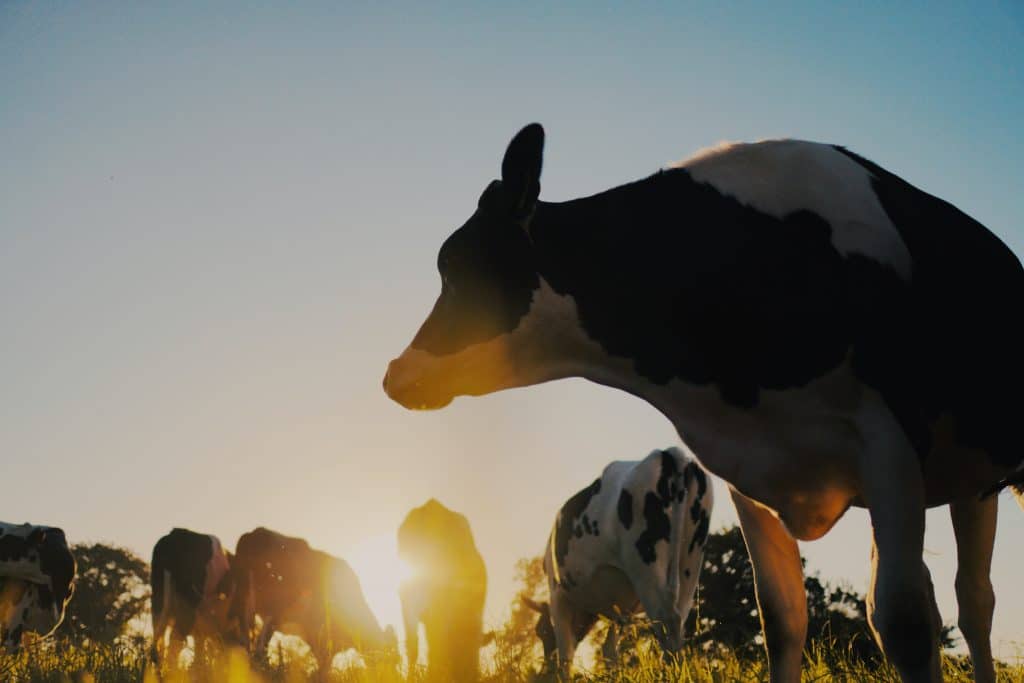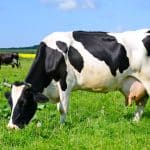Technicians have come up with an indicator of how well your cows transform feed into milk. Feed efficiency (FE) is the amount of 3.5% fat-corrected milk produced per pound of feed dry matter consumed. The optimal range of feed efficiency is 1.4 to 1.8 pounds of 3.5% fat-corrected milk produced per pound of dry matter consumed[1].
According to the university of Kentucky, different factors impact feed efficiency[2]. Some of them cannot be altered, but others can be manipulated to improve productivity. For example, factors related to health (heath stress, rumen acidosis, somatic cell count) can be improved through an early detection followed by timely intervention and appropriate management practices. Similarly, factors related to diet like additives, forage quality and fiber can be manipulated by an attentive monitoring of feeding behavior and rumination.
What affects feed efficiency?
The study identifies the effects of environmental , health and management factors on feed efficiency :
- Rumen Acidosis: If cows experience subacute rumen acidosis, Feed Efficiency may decrease by 0.1 units.
- Feed Additives: The inclusion of yeast, yeast culture, buffers, or direct-fed microbials in the diet can boost feed efficiency by 0.1 to 0.5 units.
- Forage Quality: Enhanced forage quality enhances feed efficiency, while lower forage quality hampers it. Improved forage quality leads to increased forage intake, digestibility, and subsequently, milk production.
- Fiber Content: As the percentage of NDF (Neutral Detergent Fiber) rises, feed efficiency tends to decline, except when NDF in the total diet reaches 35% and above, at which point feed efficiency remains stable.
- Heat Stress: With an increase in heat stress levels, feed efficiency typically decreases. This decrease can range between 0.1 and 0.3 units, according to the intensity of stress.
A case study : how much milk and money can you save by preventing heat stress?
While automatic monitoring cannot cure cows once they fall ill, it can effectively prevent health issues by promptly detecting anomalies or signs of animal discomfort before they escalate into illnesses or reach critical stages. It can also mitigate the impact of environmental stresses by alerting farmers and helping them to implement protective measures for the herd before health and productivity are negatively impacted. This proactive approach can lead to significant cost savings for dairy farms. For example, in order to mitigate heat stress different practices can be put in place to help cows cope with high temperatures : changing feeding time and feed quality, increase available water, provide shade and ventilation, improve the design of livestock buildings..
The financial benefits on a 100-cows farm
To understand the financial benefits of health and rumination monitoring on feed efficiency and milk production, let’s calculate the value of preventing heat stress in a farm with 100 cows. This calculation focuses on milk production and the revenue it generates. Assuming an optimal feed efficiency of 1.6 (meaning 1.6 pounds of milk for every 1 pound of feed), avoiding heat stress can prevent a reduction of 0.3 pounds of milk per pound of feed. This equates to preventing a 19% loss in milk production. For a Holstein cow producing an average of 75 pounds of milk daily[1], this translates to maintaining 14 pounds of milk per cow each day, that would otherwise be lost because of heat stress.
Given a milk price of $0.196 per pound ([2]), a 100-cow farm can save approximately $274 daily or $1917 weekly by preventing heat stress. This is calculated as 140 pounds of additional milk daily multiplied by the milk price ($0.196), resulting in these significant savings. According to recent research, almost 80% of cattle globally are exposed to heat stress for at least 30 days a year[3]. So, in this hypothetical case, we can estimate the cost savings associated with maintaining milk yield thanks to the prevention of heat stress as 274 x 30 = $ 8220/year.

[1] https://www.holsteinusa.com/holstein_breed/holstein101.html?tab=2#TabbedPanels1
[2] https://www.clal.it/en/?section=latte_usa&type=CL4
[3] North MA et al (2023) Global risk of heat stress to cattle from climate change. Environ. Res. Lett. 18 094027
Integrating monitoring data and feed efficiency for a holistic farm management
Information on feed efficiency can be effectively combined with data on rumination and ingestion for informed decision-making aimed at optimizing nutrition and maximizing production over feed intake. The integration of these datasets proves advantageous as it allows for the correlation of deviations in behavioral patterns with changes in feed efficiency, thereby facilitating the identification of underlying causes such as health issues, feed types, or environmental changes.
For instance, if reduced feeding and rumination times are observed without a change in feed efficiency, it may indicate competition within the herd leading to decreased access to feed. Conversely, alterations in both indicators could signify metabolic diseases. The synergy of these datasets enhances the ability to discern the factors influencing herd behavior and productivity.
Farm Life: detecting and preventing feeding and rumination issues for dairy farm success
To facilitate the detection and identification of feeding and rumination-related issues, automatic monitoring tools serve as invaluable allies. They detect abnormal behaviors, integrate various indicators effectively, and ensure comprehensive control within the dairy farm
This advanced approach relies on sensors that continuously collect real-time data, utilizing 3D accelerometers and artificial intelligence algorithms to detect deviations and issue timely warnings to farmers.
FarmLife is a comprehensive solution that uses real time data from sensors mounted on collars. These are combined and analyzed with artificial intelligence to provide a holistic view of cow health status, reproductive performance, rumination, and activity behavior.
If you want to know more about FarmLife, click here.
[1] https://dairy-cattle.extension.org/when-calculating-feed-efficiency-how-do-you-account-for-variations-in-milk-fat-test/
[2] https://afs.ca.uky.edu/dairy/ten-factors-which-impact-dairy-feed-efficiency



